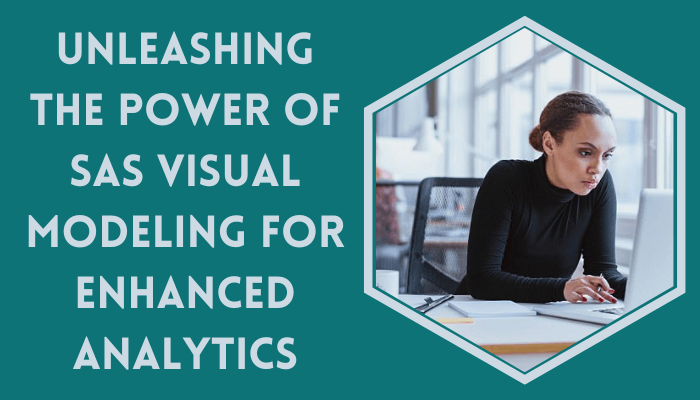Data analytics is growing unprecedentedly, with organizations of all sizes and types relying on data-driven insights to make informed decisions. SAS Visual Modeling is one technology transforming how businesses and organizations approach analytics. In this article, we will dive into the features and benefits of this powerful tool and explore how it can improve your data analytics capabilities.
As the demand for data analytics continues to grow, businesses and organizations are turning to advanced tools and technologies to pull insights from their data. SAS Visual Modeling is one such technology that allows analysts to quickly and efficiently build, test, and deploy predictive models, all while leveraging the power of the SAS platform.
Analysts can access data mining and machine learning algorithms with SAS Visual Modeling, including regression, clustering, decision trees, and neural networks. These algorithms can solve business problems, from customer segmentation and fraud detection to demand forecasting and supply chain optimization.
Features and Advantages of SAS Visual Modeling
SAS Visual Modeling offers a range of features and benefits that make it a powerful tool for data analytics. Some of the key features and advantages of SAS Visual Modeling include the following:
- Ease of Use: SAS Visual Modeling provides a user-friendly interface that allows analysts to quickly and easily build predictive models without complex coding.
- Broad Range of Algorithms: SAS Visual Modeling includes a wide range of data mining and machine learning algorithms, including regression, clustering, decision trees, and neural networks.
- Scalability: SAS Visual Modeling is designed to handle large data sets, making it ideal for businesses and organizations that deal with big data.
- Collaboration: SAS Visual Modeling contains features that allow multiple users to work together on a project, making it easier to share insights and knowledge.
- Integration with SAS Platform: SAS Visual Modeling is fully integrated with the SAS platform, making it easy to connect with other SAS tools and technologies for enhanced analytics.
SAS Visual Modeling Certification: A Career Boost for Aspiring Data Analysts
The demand for data analysts is growing unprecedentedly, with businesses and organizations across industries relying on data-driven insights to make informed decisions. As the field of data analytics continues to evolve, it is becoming increasingly essential for data analysts to possess the skills and certifications necessary to stay ahead of the curve.
One certification that is gaining popularity among data analysts is the SAS Visual Modeling certification. This certification program is designed to equip data analysts with the skills and knowledge to build, test, and deploy predictive models using the SAS Visual Modeling tool.
By earning the SAS Visual Modeling certification, data analysts can show their expertise in predictive modeling and machine learning, leading to better job opportunities, increased salary potential, and enhanced career growth.
Preparing for the SAS Visual Modeling Certification Exam
The SAS Visual Modeling certification exam tests a data analyst’s knowledge of predictive modeling and machine learning using SAS Visual Modeling. Data analysts should consider taking online courses, attending webinars, and participating in live training sessions to prepare for the exam.
In addition, SAS offers a range of study materials and practice exams to help data analysts prepare for the certification exam. These study materials include sample questions, case studies, and reference guides that cover the key concepts and techniques used in SAS Visual Modeling.
Benefits of SAS Visual Modeling
- Demonstrated Expertise: Earning the SAS Visual Modeling certification shows employers and colleagues that a data analyst has the skills and knowledge necessary to build, test, and deploy predictive models using SAS Visual Modeling.
- Career Advancement: SAS Visual Modeling certification can lead to better job opportunities, increased salary potential, and enhanced career growth for data analysts.
- Industry Recognition: The SAS Visual Modeling certification is widely recognized as a benchmark for predictive modeling and machine learning skills.
- Ticket to SAS Learning Resources: By enrolling in the SAS Visual Modeling certification program, data analysts can access many learning resources, including online courses, webinars, and live training sessions.
- Continued Professional Development: SAS offers a range of certification programs and courses that let data analysts continue their professional development and stay up-to-date with the latest industry trends and technologies.
How Visual Modeling Can Enhance Your Data Analytics Capabilities?
By leveraging the features and benefits of SAS Visual Modeling, businesses, and organizations can improve their data analytics capabilities in some ways. Some of the key benefits of using SAS Visual Modeling include the following:
- Improved Accuracy: SAS Visual Modeling allows analysts to build predictive models that can accurately predict future outcomes, making it easier to make informed decisions.
- Increased Efficiency: SAS Visual Modeling allows analysts to quickly build, test, and deploy predictive models, reducing the time and effort required for data analytics.
- Enhanced Insights: SAS Visual Modeling allows analysts to uncover insights and patterns in data that may be difficult to identify using traditional data analytics methods.
- Better Collaboration: SAS Visual Modeling includes features that let multiple users work together on a project, making it easier to share insights and knowledge across an organization.
Conclusion
The SAS certification is a valuable asset for data analysts who want to show their expertise in predictive modeling and machine learning using SAS Visual Modeling. By earning this certification, data analysts can enhance their career prospects, increase their salary potential, and stay up-to-date with industry trends and technologies. With the growing demand for data analysts, earning the SAS Visual Modeling certification can significantly boost a data analyst’s career.






